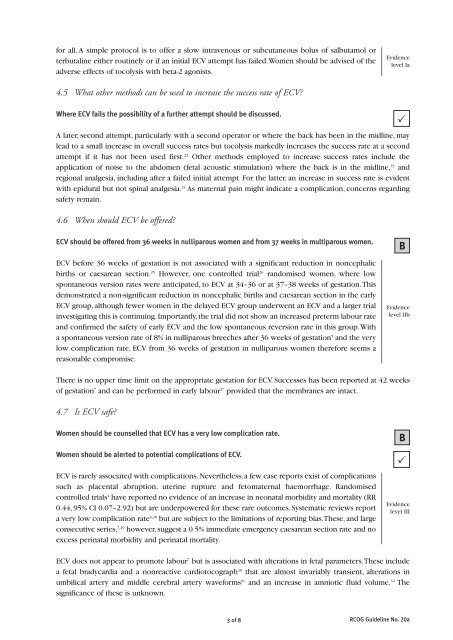External Cephalic Version and Reducing the Incidence of Breech ...
External Cephalic Version and Reducing the Incidence of Breech ...
External Cephalic Version and Reducing the Incidence of Breech ...
You also want an ePaper? Increase the reach of your titles
YUMPU automatically turns print PDFs into web optimized ePapers that Google loves.
for all. A simple protocol is to <strong>of</strong>fer a slow intravenous or subcutaneous bolus <strong>of</strong> salbutamol or<br />
terbutaline ei<strong>the</strong>r routinely or if an initial ECV attempt has failed. Women should be advised <strong>of</strong> <strong>the</strong><br />
adverse effects <strong>of</strong> tocolysis with beta-2 agonists.<br />
Evidence<br />
level Ia<br />
4.5 What o<strong>the</strong>r methods can be used to increase <strong>the</strong> success rate <strong>of</strong> ECV<br />
Where ECV fails <strong>the</strong> possibility <strong>of</strong> a fur<strong>the</strong>r attempt should be discussed.<br />
A later, second attempt, particularly with a second operator or where <strong>the</strong> back has been in <strong>the</strong> midline, may<br />
lead to a small increase in overall success rates but tocolysis markedly increases <strong>the</strong> success rate at a second<br />
attempt if it has not been used first. 22 O<strong>the</strong>r methods employed to increase success rates include <strong>the</strong><br />
application <strong>of</strong> noise to <strong>the</strong> abdomen (fetal acoustic stimulation) where <strong>the</strong> back is in <strong>the</strong> midline, 23 <strong>and</strong><br />
regional analgesia, including after a failed initial attempt. For <strong>the</strong> latter, an increase in success rate is evident<br />
with epidural but not spinal analgesia. 24 As maternal pain might indicate a complication, concerns regarding<br />
safety remain.<br />
4.6 When should ECV be <strong>of</strong>fered<br />
̌<br />
ECV should be <strong>of</strong>fered from 36 weeks in nulliparous women <strong>and</strong> from 37 weeks in multiparous women.<br />
ECV before 36 weeks <strong>of</strong> gestation is not associated with a significant reduction in noncephalic<br />
births or caesarean section. 25 However, one controlled trial 26 r<strong>and</strong>omised women, where low<br />
spontaneous version rates were anticipated, to ECV at 34–36 or at 37–38 weeks <strong>of</strong> gestation. This<br />
demonstrated a non-significant reduction in noncephalic births <strong>and</strong> caesarean section in <strong>the</strong> early<br />
ECV group, although fewer women in <strong>the</strong> delayed ECV group underwent an ECV <strong>and</strong> a larger trial<br />
investigating this is continuing. Importantly, <strong>the</strong> trial did not show an increased preterm labour rate<br />
<strong>and</strong> confirmed <strong>the</strong> safety <strong>of</strong> early ECV <strong>and</strong> <strong>the</strong> low spontaneous reversion rate in this group. With<br />
a spontaneous version rate <strong>of</strong> 8% in nulliparous breeches after 36 weeks <strong>of</strong> gestation 5 <strong>and</strong> <strong>the</strong> very<br />
low complication rate, ECV from 36 weeks <strong>of</strong> gestation in nulliparous women <strong>the</strong>refore seems a<br />
reasonable compromise.<br />
B<br />
Evidence<br />
level IIb<br />
There is no upper time limit on <strong>the</strong> appropriate gestation for ECV. Successes has been reported at 42 weeks<br />
<strong>of</strong> gestation 7 <strong>and</strong> can be performed in early labour 27 provided that <strong>the</strong> membranes are intact.<br />
4.7 Is ECV safe<br />
Women should be counselled that ECV has a very low complication rate.<br />
Women should be alerted to potential complications <strong>of</strong> ECV.<br />
ECV is rarely associated with complications. Never<strong>the</strong>less, a few case reports exist <strong>of</strong> complications<br />
such as placental abruption, uterine rupture <strong>and</strong> fetomaternal haemorrhage. R<strong>and</strong>omised<br />
controlled trials 4 have reported no evidence <strong>of</strong> an increase in neonatal morbidity <strong>and</strong> mortality (RR<br />
0.44, 95% CI 0.07–2.92) but are underpowered for <strong>the</strong>se rare outcomes. Systematic reviews report<br />
a very low complication rate 6,28 but are subject to <strong>the</strong> limitations <strong>of</strong> reporting bias. These, <strong>and</strong> large<br />
consecutive series, 7,29 however, suggest a 0.5% immediate emergency caesarean section rate <strong>and</strong> no<br />
excess perinatal morbidity <strong>and</strong> perinatal mortality.<br />
B<br />
̌<br />
Evidence<br />
level III<br />
ECV does not appear to promote labour 7 but is associated with alterations in fetal parameters. These include<br />
a fetal bradycardia <strong>and</strong> a nonreactive cardiotocograph 30 that are almost invariably transient, alterations in<br />
umbilical artery <strong>and</strong> middle cerebral artery waveforms 31 <strong>and</strong> an increase in amniotic fluid volume. 32 The<br />
significance <strong>of</strong> <strong>the</strong>se is unknown.<br />
3 <strong>of</strong> 8 RCOG Guideline No. 20a
















